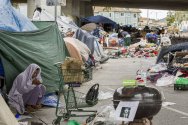China backs Iran in times of crisis
Iran and China are among the Biden’s administration’s top foreign policy challenges especially as the two get closer. Iran, overburdened by internal corruption, international sanctions and the worst coronavirus outbreak in the region, has turned east to China in the past year for economic and military support. Despite an acute debt crisis which has led Beijing to pull back from its massive Belt and Road Initiative, falling Iranian crude oil prices have enticed China to explore astute, even covert, alternatives for a guaranteed, discounted source of energy, undermining US policy in the process. In fact, the US Treasury sanctioned Chinese companies at least twice this year for trade with Iran.China has been, since 2017, the world’s largest importer of oil and depends increasingly on the Middle East for it. It sees Iran as both a critical supplier of energy resources and participant in the BRI, its global infrastructure mega-project. China considers freedom of navigation in the Persian Gulf as critical to protecting its interests. But in 2020, Beijing purchased only 3 million tons of Iranian oil, down 77 percent from 2019.
The Biden administration offers hope that, with the return to a nuclear deal and the easing of sanctions, oil will begin to flow vigorously again. But barring systemic reform that will improve Western business confidence, Iran--and its leadership--is still reliant on Chinese economic engagement, especially with presidential elections approaching in June 2021.
The draft of an ambitious 25-year strategic deal with China (envisioning $400 billion worth of investment projects) leaked in July, signaled China’s intent to play a larger role in the region. This has coincided with other prominent leaders in the MENA-region turning to Beijing for grand infrastructure investments, looking to Saudi Arabia’s Vision 2020 and Syrian regime-led reconstruction as examples.
China controls 75 percent of Sudan’s oil industry, will start running Israel’s Haifa port in 2021 and has largely built new Cairo Capital’s central business district. However, these building blocks of influence, while yielding economic leverage, have not yet translated into substantial political clout. The deepening relationship will nonetheless infuse much needed investment in infrastructure, banks, communications, cybersecurity and intelligence, along with military cooperation in return for discounted oil and gas, offering the Iranian regime an economic—and certainly political-- lifeline.
Today, Iran is cash-strapped and the economy is in shambles. The IMF predicted a 6 percent contraction of the economy while inflation hovers around 34 percent. The rial has lost 85 percent of its value since 2018, hitting an all-time low against the dollar in October. The country has also recorded a staggering number of coronavirus cases—over a million--and more than 50,000 deaths in a country of 80 million. The health system is on its last legs with shortages of equipment, supplies and personnel.
China is expected to profit from the billion-dollar infrastructure projects; it will also gain a strategic foothold on the Belt and Road corridor linking with major markets in Asia, Europe and Africa. But, rather than alleviate the suffering of ordinary Iranian by revitalizing the economy and alleviating poverty, China’s financial involvement in Iran has only strengthened the regime’s grip on power. Anger and dissent over the economy in the last year sparked increasingly brutal repression by the regime. The resulting consolidation of the repressive state apparatus will ultimately further curtail the livelihood and freedoms of Iranian citizens.
What is likewise significant about the partnership is that both China and Iran have broader regional and global ambitions and they are foes of the US. Though China has already challenged the US in East Asia, the Middle East—and indeed Iran--may become the new battlefield for a confrontation between the two.
China providing resources to Tehran’s sanctions-afflicted economy can only bolster Iran’s theocratic, repressive and kleptocratic regime that is presently squeezed. Tehran’s leadership is still reeling from the after-shock of repeated nationwide protests and desperate for a well-choreographed presidential election next June. The influx of cash may have initial, remedial effects of improving the purchasing power of Iranians by reducing hyperinflation, but the high will be fleeting.
In the long-run, it will serve to constrain citizen’s livelihood and economic wellbeing, and, more importantly, further erode the civil liberties of ordinary Iranians with investments bolstering IRGC controlled sectors, wealth pilfered and funneled to domestic elite and destabilizing regional exploits. Local pushback against China’s encroachment has already manifested themselves in public awareness campaigns of its nefarious impact like the hashtags “Don’t sell Iran” and “Chinese Turkemenchay.”
Though these may have little impact on regime policies, they signal, in a context where dissent is not tolerated, growing discontent with the regime. This realization is that the potential economic lifeline provided will only perpetuate underlying economic mismanagement and corruption as the regime emerges stronger, more confident and more authoritarian.
-------------
Towards the end of the article it sidelined into how China makes Iran more authoritarian.



